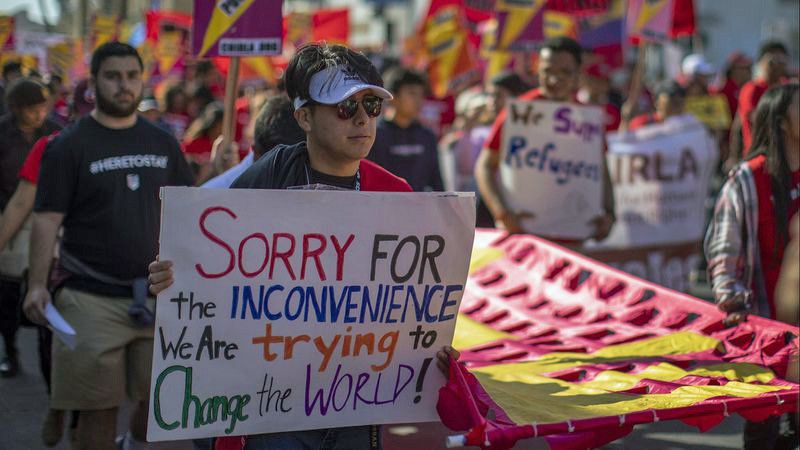Distracted by President Trump and his riled resisters, it’s easy to miss the big picture of foreign migration to California.
It’s the old story of not seeing the forest for the trees.
Portrayed in this forest grandeur is a new story in the long history of people uprooting and migrating to California chasing opportunities and dreams.
It is the story of many newly arrived immigrants — especially from Asia — being better educated than U.S.-born citizens.
They’re not starting at the bottom of the work ladder as Chinese laborers did 150 years ago when they risked life and limb to help build the Transcontinental Railroad through the granite Sierra.
True, many Latin Americans are still migrating here to work in the fields and harvest crops — although not nearly enough of them, farmers say — or wash dishes in four-star restaurants. But many of them also are much better educated than their predecessors.
“It’s the old story of immigrants coming to the U.S. and California seeking a better life for themselves and their children,” says Hans Johnson, an immigration and demographics expert at the nonpartisan Public Policy Institute of California.
“What’s different now is the trend toward immigrants coming into California with high levels of education. The share of those who already have completed college is extremely high. Asian immigrants are the best educated group in California, better than U.S.-born. Immigrants from India are the single best educated group in our state.”
And the increasing education levels of Latin American migrants, Johnson says, “means there are fewer lower-skilled immigrants and a smaller pool of farm workers than there used to be.”
But California’s economy still relies on immigrants with little education, Johnson notes in a PPIC research paper released last week. The report is based on immigration figures through 2017, the latest available.
In 2017, Johnson reports, 32% of working-age California immigrants had not graduated from high school. They primarily worked in the agriculture and hospitality industries.
But that same year, 52% of working-age immigrants who had lived in the U.S. for five years or less had at least bachelor’s degrees — up 30 percentage points since 1990. In contrast, only 37% of U.S.-born Californians were college graduates — up just 10 points since 1990.
And in 2017, 55% of newly arrived immigrants were from Asia, roughly double the number from Latin America, 29%. The majority from Asia had at least a bachelor’s degree — and 80% of immigrants from India did.
Of all California workers with bachelor’s degrees, about 30% were immigrants. The overwhelming majority of college grads working in electronics and product manufacturing were immigrants.
What’s attracting them to California now is not railroad building, gold strikes or even farm harvests, but technology, especially in Silicon Valley and the Los Angeles basin.
“Silicon Valley is drawing in immigrants,” Johnson says.
There are five counties where more than a third of the population comprises immigrants. And the top three are in and around Silicon Valley: Santa Clara, San Francisco and San Mateo. The other two are Alameda, across the bay from Silicon Valley, and Los Angeles.
The influx of college-educated immigrants couldn’t come at a better time. California needs these people to replace U.S.-born, college-educated baby boomers who are rapidly retiring, Johnson says. The U.S. birthrate hasn’t kept up with the retirement pace.
“The number of college grads leaving the labor market is at a record high,” Johnson says. “We’ve never seen in the history of California, or the U.S., such a large and highly educated cohort of people leaving the labor force. We need more highly educated workers in California.”
And many are arriving from foreign countries to fill the void.
There’s much more happening with immigration than border walls, family separations, caravans of refugees from violent Central America and demagogic diatribe.
In his research, Johnson concluded there are almost 11 million immigrants in California, about a quarter of the foreign-born population nationwide. That’s 27% of California’s population, more than double the percentage of foreign-born for the rest of the country.
Only about 14% of immigrants are in California illegally. That’s 1.5 million people, down from 2 million in 2010.
Half of California immigrants are from Latin America; 40% from Asia. The main countries of origin are Mexico (4.1 million), China (969,000), the Philippines (857,000), Vietnam (524,000) and India (507,000).
But since 2010, most immigrants — 56% — have arrived from Asia; 29% from Latin America.
Illegal immigration from Mexico has tailed off and it has little to do with anything Trump has tried. It started early in President Obama’s administration and probably was partly due to his stepped-up deportations. But mainly it was because of a better job market in Mexico.
“Labor opportunities in Mexico have generally been improving,” the researcher says. “Population growth has slowed as birthrates have come way down. The number of new workers has declined dramatically, which translates into fewer people in the labor force.” And that means less competition for jobs.
Birthrates are falling because more women are working, he says. That’s happening in many developed countries, including ours.
Meanwhile, California’s technology hub is attracting a much-needed, highly educated workforce.
The state is changing for the better before our eyes. But probably few of us are noticing.





